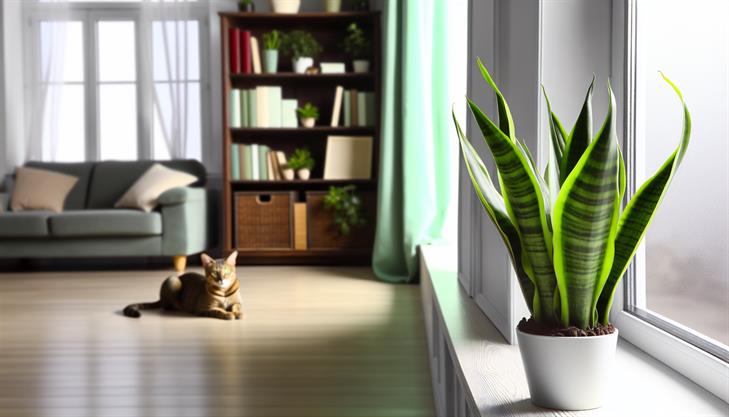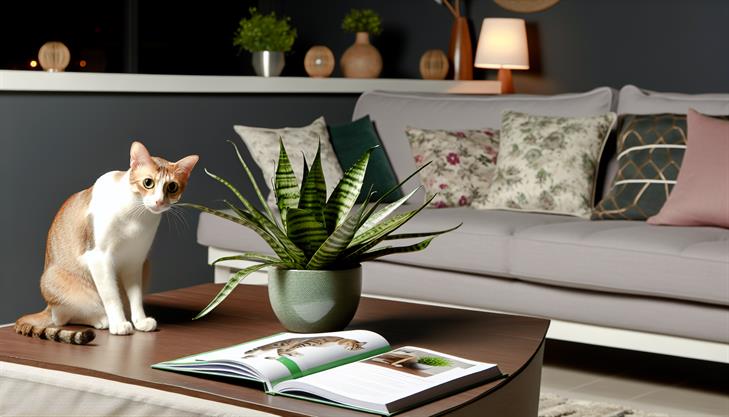For the cat-loving plant enthusiasts among us, the allure of vibrant greenery in our homes often raises a challenging question: which plants are safe for our feline companions to frolic among? One popular houseplant that often garners attention for its sleek, sword-shaped leaves and low-maintenance appeal is the Sansevieria, commonly known as the Snake Plant. But as charming as it may be, a crucial question lurks: is Sansevieria toxic to cats?
Understanding the potential hazards that our beloved plants may pose to our curious cats is not only crucial for their health but also for the peace of mind of any pet owner. In this blog post, we dive into the heart of this question, shedding light on the chemical makeup of the Sansevieria, the symptoms of toxicity, and practical steps to keep your furry friends safe. Equip yourself with this vital knowledge to create a harmonious living space that caters to both your aesthetic preferences and your cat’s well-being. Read on to explore the delicate balance between flora and feline, ensuring your home remains a safe haven for every member of your household, both two and four-legged.
Understanding the Toxic Compounds in Sansevieria
Sansevieria, commonly known as Snake Plant or Mother-in-Law’s Tongue, is a popular houseplant due to its hardy nature and attractive leaves. However, for cat owners, an important question arises: is Sansevieria toxic to cats? Understanding the potential risks associated with Sansevieria and its effects on pets is crucial for ensuring a safe living environment.
Sansevieria contains saponins, which are toxic compounds that can cause adverse reactions in cats if ingested. These compounds act as natural insecticides and fungicides, helping the plant protect itself from pests. Unfortunately, when a curious cat takes a nibble on the leaves, saponins can irritate the digestive system of the pet.
Signs of Sansevieria Toxicity in Cats
If a cat chews on Sansevieria, they may exhibit several symptoms. Typical signs of Sansevieria toxicity in cats include:
- Vomiting: One of the primary symptoms, it results from the body’s attempt to expel the toxins.
- Diarrhea: Gastrointestinal distress often accompanies vomiting.
- Excessive Drooling: A cat may salivate more than usual due to irritation caused by the ingested plant.
- Lethargy: The discomfort and dehydration from vomiting and diarrhea can lead to unusual tiredness.
Preventive Measures and Setup Tips
To prevent your feline friend from ingesting the plant, follow these steps:
- Placement: Position the Sansevieria out of the cat’s reach. Place the pot on a tall shelf or hang the plant using ceiling hangers.
- Deterrents: Use cat deterrents such as orange peels or commercial sprays around the plant to discourage interest.
- Provide Alternatives: Ensure your cat has access to safe grass or catnip to satisfy their chewing instincts.
- Supervision: When introducing any new plant into your home, monitor your cat’s behavior towards it to gauge their interest.
What to Do if Ingestion Occurs
If you suspect your cat has ingested Sansevieria, prompt action is essential:
- Remove Plant Access: Immediately move the plant to prevent further ingestion.
- Observe Symptoms: Take note of any symptoms like those mentioned before.
- Contact a Veterinarian: Consult a vet as soon as possible, providing details about the plant and symptoms.
- Follow Professional Advice: The vet may instruct you to bring your cat in for evaluation or monitor them at home depending on the severity of the symptoms.
Additional Advice
For those with a green thumb wanting to add Sansevieria to their indoor garden while still ensuring their cat’s safety, consider creating a designated plant area that is inaccessible to pets. Alternatively, you can grow Sansevieria outdoors in areas not frequented by your cat. Remember, always research the safety of any plant you introduce to a home shared with pets.
Understanding that while Sansevieria is a visually appealing and low-maintenance plant, it poses toxicity risks to cats is pivotal for pet owners. By taking preventive steps and knowing how to react to potential exposure, you can maintain a harmonious and safe environment for both your plants and furry companions.
Symptoms of Sansevieria Poisoning in Cats
Sansevieria, commonly known as snake plant or mother-in-law’s tongue, is a popular ornamental plant cherished for its hardiness and air-purifying qualities. However, for pet owners, understanding the potential risks associated with indoor plants is crucial. So, is sansevieria toxic to cats? Unfortunately, the answer is yes. The snake plant contains saponins, a compound toxic to cats and can cause a range of symptoms if ingested.
When a cat consumes parts of the sansevieria, whether it’s the leaves or flowers, they may experience a variety of symptoms. Owners should be vigilant and recognize signs such as:
-
Nausea and Vomiting: One of the first and most common reactions. If your cat suddenly begins to vomit frequently, and sansevieria is within their reach, it’s essential to consider this as a potential cause.
-
Diarrhea: Digestive disturbances like diarrhea can occur as the cat’s body attempts to rid itself of the toxins.
-
Salivation: An increase in salivation may be noticed, as the cat might try to clear the bitter taste from their mouth.
-
Lethargy and Loss of Appetite: Due to discomfort or nausea, your cat may become unusually lethargic and show little interest in eating.
-
Mouth Irritation: Ingestion may lead to oral irritation, causing the cat to paw at their mouth or exhibit signs of mouth discomfort.
If you suspect your cat has been poisoned by sansevieria, the first step is to remove any remaining plant material from their mouth to prevent further ingestion. Then, provide them with access to fresh water to help dilute the toxin in their system. It’s important to contact your veterinarian promptly, as they can offer precise guidance and also decide if the cat requires a veterinary visit for supportive care.
For cat owners who love plants but want to avoid toxic risks, consider opting for safe alternatives such as spider plants, certain ferns, or bamboo palms, which offer the same aesthetic appeal without the toxicity threat. Additionally, to prevent accidental ingestion, place toxic plants like sansevieria out of your cat’s reach, considering hanging baskets or shelves.
Understanding the potential risks of plants like sansevieria is key to maintaining a safe environment for your feline friends. By recognizing the symptoms and taking immediate action, you can help ensure your cat remains healthy and free from harm.
Preventive Measures to Protect Your Feline Friend
Sansevieria, commonly known as snake plant or mother-in-law’s tongue, is a popular houseplant admired for its robust nature and low maintenance requirements. However, it’s important to be aware that sansevieria is toxic to cats. This plant contains saponins, a natural substance that protects plants from insects and microbes, but can cause harm if ingested by your feline companions.
Understanding the Risks
Cats are curious creatures, and they often nibble on houseplants. If a cat ingests parts of a sansevieria plant, it might experience mild to moderate symptoms of poisoning. These can include vomiting, diarrhea, and excessive salivation. In some cases, the cat may also exhibit signs of distress or lethargy. While the reaction is often non-lethal, it’s crucial to prevent your cat from accessing this plant to avoid any discomfort or potential complications.
Preventive Measures
-
Place Plants Out of Reach: The most straightforward strategy is to position the sansevieria in a location that your cat cannot access. High shelves or hanging planters are excellent options. Ensure that there are no furniture pieces or structures nearby that your cat could climb.
-
Train Your Cat: Utilize positive reinforcement techniques to train your cat to stay away from indoor plants. You can use toys or treats to redirect their attention. Consistently rewarding your cat for ignoring plants can help reinforce this behavior.
-
Use Deterrents: Consider using natural deterrents to discourage your cat from approaching the snake plant. Citrus peels or sprays with scents that cats generally dislike can be effective. Always opt for cat-friendly options to avoid introducing new hazards.
-
Provide Safe Alternatives: Cats often chew on plants out of boredom or nutritional curiosity. Introduce cat-friendly plants like wheatgrass or catnip, which are safe for them to explore and consume. This provides a healthy alternative and may curtail their interest in potentially harmful plants.
-
Educate Family Members: Ensure that everyone in your household is aware of the potential dangers associated with sansevieria and other toxic plants. Consistent communication can prevent accidental exposure and help maintain a safe environment for your pet.
Additional Considerations
-
Veterinary Consultation: If you suspect your cat has ingested sansevieria, consult a veterinarian promptly. Providing details about the plant and the amount consumed, if known, can aid in swift diagnosis and treatment.
-
Household Safety Check: Regularly inspect other plants and substances in your home to ensure they’re not toxic to cats. Many common houseplants and household items can pose a risk, so taking a thorough inventory can mitigate potential hazards.
Creating a safe living space for your cat involves a balance between plant enjoyment and pet protection. With these preventive steps, you can enjoy the aesthetic benefits of sansevieria while ensuring the well-being of your feline friend.
First Aid Steps if Your Cat Ingests Sansevieria
Sansevieria, commonly known as snake plant or mother-in-law’s tongue, is a popular houseplant known for its sleek appearance and low maintenance requirements. However, for cat owners, the question often arises: Is sansevieria toxic to cats? The answer is yes; sansevieria contains chemical compounds called saponins, which are toxic to cats if ingested.
Recognizing Symptoms of Sansevieria Poisoning
If your cat has ingested any part of a sansevieria plant, it may show various symptoms indicating toxicity. Look for signs such as vomiting, diarrhea, excessive drooling, and nausea. Some cats may also display signs of lethargy or lack of appetite.
First Aid Steps for Sansevieria Ingestion
If you suspect your cat has ingested sansevieria, follow these immediate first aid steps:
-
Stay Calm: It’s crucial to remain calm so you can think clearly and act swiftly.
-
Remove Access: Ensure your cat cannot access the plant again, and if possible, move the plant to a location that your cat cannot reach.
-
Assess Your Cat’s Symptoms: Take note of any signs your cat is displaying, such as those mentioned above.
-
Contact Your Veterinarian: Immediately call your veterinarian to discuss the symptoms and seek guidance. You can also contact an emergency animal poison control hotline for advice.
-
Follow Professional Instructions: Based on professional advice, you may need to bring your cat to the clinic for a more thorough examination and treatment.
-
Do Not Induce Vomiting: Unless specifically instructed by a veterinarian, do not attempt to induce vomiting, as this can sometimes worsen the situation.
Preventing Future Accidental Ingestion
- Place Plants Out of Reach: Ensure all toxic plants, including sansevieria, are out of reach for your cats. Hanging plants or placing them on high shelves can help.
- Choose Non-Toxic Alternatives: Consider replacing sansevieria with non-toxic plants safe for cats, like spider plants or bamboo palms.
- Use Deterrents: Apply safe-for-pets deterrent sprays on plants that might interest your cat.
- Create a Cat-Friendly Space: Provide your feline friend with a dedicated space filled with safe plants and cat grasses.
Additional Advice
Regularly inspect your home environment to identify and mitigate any potential risks posed by houseplants. Educating yourself on which plants are safe and which are toxic to cats can help you create a safer living space both for you and your pet.
In conclusion, while sansevieria is easy to care for and aesthetically pleasing, it is toxic to cats. Being informed and prepared can help you act quickly in case of accidental ingestion and ensure the safety of your feline friend.
Alternative Cat-Friendly Plants for Your Home
Sansevieria, commonly known as snake plant or mother-in-law’s tongue, is an appealing houseplant choice due to its hardy nature and striking appearance. However, for cat owners, understanding the potential risks associated with Sansevieria is crucial. One common question arises: Is Sansevieria toxic to cats?
Understanding Sansevieria Toxicity
Sansevieria is indeed toxic to cats if ingested. The plant contains saponins, chemical compounds that can cause distress in pets. Symptoms may include nausea, vomiting, diarrhea, drooling, and lethargy. Although rarely fatal, these symptoms require prompt attention to ensure your cat’s comfort and health.
Creating a Cat-Friendly Home Environment
-
Identification and Removal: First, identify if you currently have Sansevieria in your home. Its tall, stiff, upright leaves with variegated patterns are distinct. If you do have snake plants and share your space with a curious feline, consider relocating the plant to an area that is inaccessible to your cat. High shelves or enclosed terrariums can help keep your furry friend away.
-
Alternative Cat-Friendly Plants: Fortunately, there are numerous non-toxic alternatives for creating a lush and pet-safe home. Consider swapping Sansevieria with cat-friendly options such as spider plants, bamboo palms, or Boston ferns. These plants not only enhance your interior aesthetics but also provide peace of mind as they are safe for your feline companions.
-
Setup Tips for Alternative Plants:
- Choose Locations Wisely: Ensure that alternative plants are placed in well-lit areas suitable for their growth requirements, yet accessible for your cat to safely explore.
- Regular Maintenance: Non-toxic plants also require routine care. Water them as needed, check for pest infestations, and occasionally rotate them to ensure even growth.
- Provide Enrichment: Enhance your cat’s environment by providing other forms of enrichment such as scratch posts and cat grass, which can help divert attention away from potentially harmful plants.
Monitoring Your Cat
If you suspect that your cat has ingested any part of a snake plant, observe them closely for symptoms of distress. It’s crucial to seek veterinary advice immediately if symptoms appear. The veterinarian can provide supportive care and ensure that recovery is swift and complications are minimal.
Additional Advice for Plant Enthusiasts
Maintaining a balance between a love for plants and a safe environment for pets doesn’t have to be challenging. Regular research and staying informed about plant toxicity can help you make wise plant choices. Additionally, investing in plant stands or wall-mounted shelves can allow you to keep certain plants out of reach, minimizing any risk while still enjoying greenery in your home.
By understanding the toxicity of Sansevieria to cats and knowing which alternative plants are safer options, you can create a harmonious living space for both you and your feline family members.
In conclusion, it’s important for cat owners to be aware that Sansevieria, commonly known as snake plant, does pose a toxicity risk to their feline companions. Key points include the presence of saponins in the plant, which can cause gastrointestinal distress in cats if ingested. Symptoms to watch for include vomiting, diarrhea, and lethargy, which may necessitate immediate veterinary attention. However, with proper precautions, you can still enjoy the benefits of having this resilient houseplant without compromising your pet’s safety. Consider placing the snake plant in areas that are inaccessible to curious paws or opting for pet-friendly alternatives. As a final tip, regularly observe your cat’s behavior around plants and educate yourself on both common and lesser-known toxic plants to ensure a safe and harmonious home environment. By applying what you’ve learned, you can confidently cultivate a home that is both green and pet-friendly.


